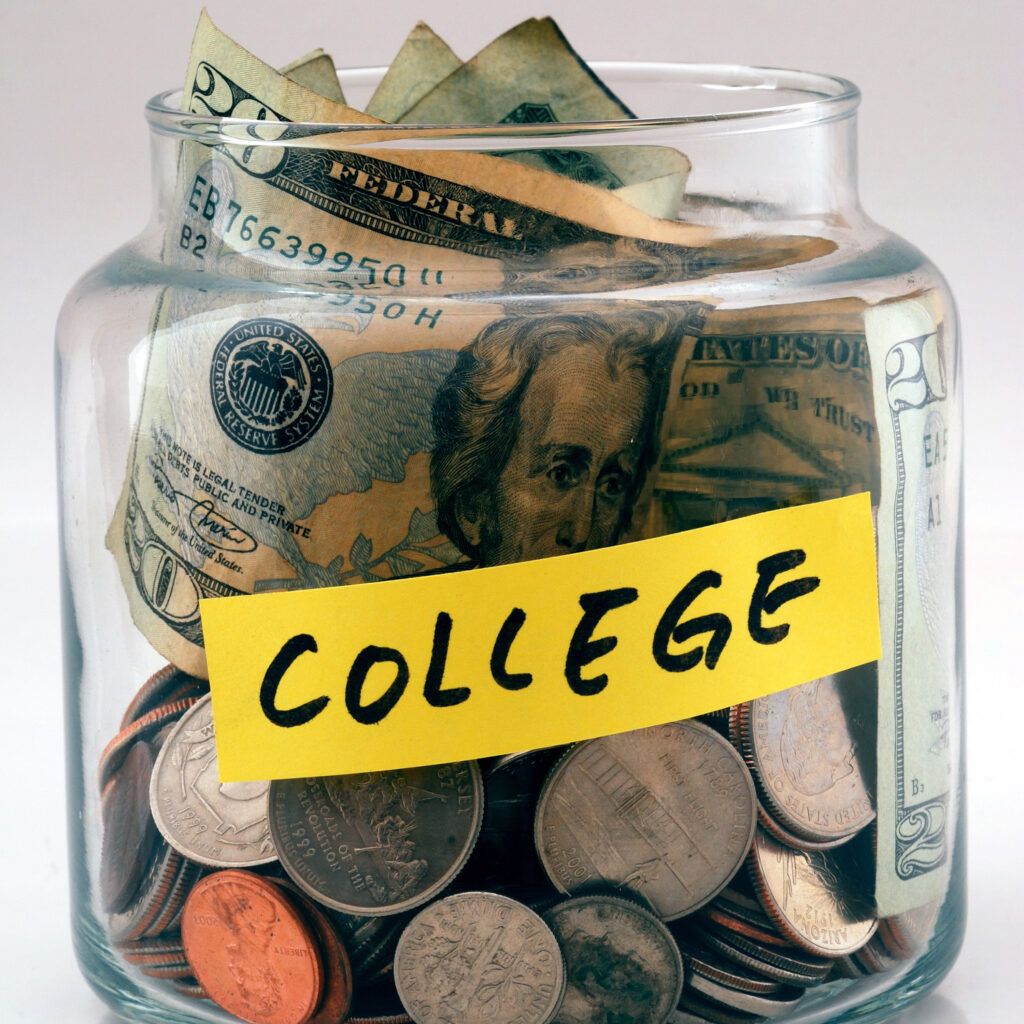EDUCATION

LEARNING EQUALS EARNING
Wait a minute, you may be saying. This website is about financial stuff. Why are we talking about education?
Short answer: because it is totally tied to your earning power, and to your financial future. Over their entire career, college graduates will have earned nearly twice the salary of workers without degrees. In today’s highly competitive workplace, companies want to invest their money on hiring the best employees they can. So your degree gives you the edge.
More perks for higher ed: college grads manage their finances better, live healthier lives, and enjoy better retirement benefits.
Not planning on higher ed? There’s still plenty you can do right now to help ensure you get yourself on the best career path. Ready for Life 101? Read on…



IS COLLEGE WORTH IT?
THE EDUCATED GUESS IS YES!
You’ve probably already had conversations with your family about the cost of going to college. No doubt about it – higher education can be extremely pricey. In fact, more than 2/3 of the entire Class of 2015 graduated with debt. And for most of them (about 67%) the amount owed was $35,000 or more. Student debt in America has now risen to over $1 trillion – that’s way beyond US credit card debt.
So is a college degree worth the money? Most experts feel that it is. When comparing young full-time workers ages 25 to 32, college grads are pulling in $17,500 a year more than those with just high school diplomas. So paying off those loans is quite do-able. One article actually computed the average cost of a college education, measured it against the average lifetime earning, and concluded that the true cost of a degree is minus $500,000. In other words, if you simply enter the workforce after high school, you will have earned one-half a million dollars less at retirement that you would have earned if you had a college degree.
That said, not all college degrees are created equal. An Ivy League school can pretty much guarantee you a higher starting salary – along with a substantially higher tuition bill. And your area of concentration matters a lot when it comes to earning power. Compare the earning potential of various degrees in our Know More section.


COLLEGE COSTS
THE DOLLARS SCHOLARS NEED
It’s practically impossible to know precisely, but if you were attending a public college or university this year, here’s a quick snapshot of what you might be paying, and what it covers:
The College Board estimates of college cost for 2017–18:
Public, four-year, in-state students: $24,061 total
- Tuition & fees – $9,410
- Room and board – $10,138
- Books & supplies – $1,298
- Personal expenses – $2,016
- Transportation – $1,109
Public, four-year, out-of-state students: $38,544 total
- Tuition & fees – $23,893
- Room and board – $10,138
- Books & supplies – $1,298
- Personal expenses – $2,106
- Transportation – $1,109
Private, non-profit, four-year, out-of-state students: $47,831 total
- Tuition & fees – $32,405
- Room and board – $11,516
- Books & supplies – $1,249
- Personal expenses – $1,628
- Transportation – $1,033
Tuition and Fees – this is what you’ll have to pay to take courses at your college. Costs can vary, depending on your major, and course load
Room and Board – on-campus residents can select from dorm options and meal plans. Those who live off-campus may have to pay out of pocket
Books and Supplies – course materials come with a hefty price tag of nearly $1300 per year. Renting texts or buying used books might be a smart alternative.
Living Expenses – you’ll need money for your cell phone bill, internet, laundry, and any social activities. Make sure you factor this cost into your budget.
Transportation – on-campus students will be going home for holidays and vacations. Don’t forget gas, insurance and maintenance if you have a car on campus.
Remember: the costs for an education at private and for-profit institutions can be much higher. And like everything else, college costs go up each year. Check out the projected cost of a four-year degree in the Know More section.
MAKE IT AFFORDABLE
A CRASH COURSE IN BUDGET-STRETCHING
It’s a given that going to college requires a financial investment. But there are many ways you can get an excellent higher education, at substantially lower cost.
Here are some suggestions:
- Work toward gaining maximum college credit for your AP courses
- Look into the ‘best value’ tier when researching colleges
- Consider a transfer. Earn excellent grades at an affordable two-year or community college, then complete your BA at a big-league school, and you’ll have practically halved your expenses
- Sleep in your own bed: save the cost of room and board by commuting to a local university
- Learn online. Many colleges offer online degree programs, complete with student support services. Check out the top choices for 2016 in the Know More section
- Get the job done in four years. 68% of all college students need more time to graduate – and as many as 44% need more than six years. That sends your overall costs skyrocketing





FREE COLLEGE?
CHECK OUT TUITION-FREE OPTIONS
Yes, you can go to college without paying tuition. Believe it or not, there are a number of schools that are tuition-free. But there may be some strings attached, such as residency and/or income requirements, on-campus work commitments, or post-college service.
Here is a list of tuition-free colleges, recommended by US News & World Report. Some may require auditions, campus jobs, or other student service. And often, room, board and books are student-paid. Contact the institutions directly for information on their requirements.
- COLLEGE OF THE OZARKS – Missouri
- BEREA COLLEGE – Kentucky
- CURTIS SCHOOL OF MUSIC – Pennsylvania
- ALICE LLOYD COLLEGE – Kentucky
- WEBB INSTITUTE – New York
- DEEP SPRINGS COLLEGE – California
- US MILITARY ACADEMY – New York
- US COAST GUARD ACADEMY – Connecticut
- US NAVAL ACADEMY – Maryland
- US AIR FORCE ACADEMY – Colorado
- US MERCHANT MARINE ACADEMY – New York
Find more tuition-free colleges in the Know More section.
Another educational ‘freebie’ is to become an apprentice, and get on-the-job paid training as you learn a skilled occupation. The government actually awards grants to companies to expand their apprenticeships programs. So it’s a win-win: companies pledge to train and hire new apprentices and you get trained in growing industries. Start your search on the Department of Labor’s website. You’ll find the link in the Know More section.
JUNIOR YEAR CHECKLIST
YOUR FIRST STEPS TOWARD COLLEGE
Most students think their college or career life begins after senior year. But the fact is, the junior year of high school is critical in positioning you for the future that begins on graduation. This is when you begin to decide which particular colleges or careers interest you. And this is your golden opportunity to prepare for a smooth entrée to your chosen path. Sounds daunting, but you’ll ace junior year if you follow these steps:
- Schedule Smartly. This will be the last full year of courses and grades that your college admissions committees will be reviewing. Make your course load impressive: choose advanced placement and honors classes if you can (but don’t overfill your schedule with more classes than you can handle well.) In short, let your course load show you can tackle rigorous classes, and are ready to succeed in a college environment.
- Prepare to be Tested. Junior year will start with the PSAT/NMSQT test. Good scores on this may help you snag a merit scholarship, and will help you get ready for the SAT that comes in spring. Taking advanced placement courses? The AP Placement Tests, taken in May, will decide whether you can receive college credit for your subject. At the end of junior year, you’ll be taking the SAT and ACT. These are standardized tests that are usually a required part of the college admission criteria.
- Consider Colleges. Start your collection of catalogs, from college fairs at your school, and from colleges you contact. Take advantage of the many online resources that also help you find out about each school’s rankings, financial aid, majors and minors, and student life. Your mission is to narrow the field to no more than a dozen possible choices. And your list should include ‘sure-thing’ as well as ‘big-stretch’ schools.
Meet your junior year head-on, and you’ll be perfectly poised to get the most out of your senior year, and beyond…


SENIOR YEAR CHECKLIST
START THE COLLEGE COUNTDOWN
You’ve done everything right in junior year – taken an impressive course load, perhaps received college credit for AP courses, discussed budgets with your family, researched various colleges. Now it’s time to put all your planning into action. Here’s a quick look at your college to-do list:
Summer before senior year
- Gather financial aid information and applications. It’s important to file your FAFSA forms early, because colleges base their aid on information it contains.
- Your parents should also be preparing any income data that might be required.
September, October & November
- If you haven’t already done so, create your college ‘short list,’ and visit the campuses.
- Decide if you want early decision or early action. (Be mindful that if you do apply for these, you’ll need to send your applications, test score and transcripts early.)
- Speak to your teachers, employers, clergy, etc. about letters of recommendation.
- Write a terrific college application essay.
- Mail out applications.
- Arrange for official transcripts to be sent.
- Find out what tests are required, and arrange to take them.
- Look into financial aid requirements.
December, January, February & March
- Speak to your Guidance Counselor about sending transcripts for your first semester grades, plus a schedule of your spring courses.
- Check the mailbox, because some colleges send tentative acceptances to outstanding applicants.
April, May & June
- It’s not too late to apply to a state college – they frequently accept applications until the month before freshman year begins.
- Most college will notify candidates by the middle of April.
- Answer accepting colleges, to let them know of your decision.
- Study up for the AP tests.
- Send final transcripts to your chosen college.
CAREER, NOT COLLEGE
ENTERING THE WORKPLACE
Not every student wants to go on to higher education. But your years in high school are as important to you as to college-bound kids, because they can help position you for a smooth transition into the workforce – and when used well, they can give you job-seeking advantages.
First and foremost, check with your guidance department about technical and career training classes available to high school students. Check into adult and continuing education offerings too. These classes can help you decide whether a field interests you as a career option.
There are many other ‘non-college’ education and training options you might want to consider that help you gain skills specific to a chosen field.
These include:
- Vocational Schools. These train students for a variety of skilled jobs, such as paralegals, dental assisting, cosmetology, culinary arts, etc. You will receive a certificate of completion. Frequently community colleges offer vocational programs, in which case you can earn an associates degree. In addition to requiring less education than four-year degrees, many of these programs offer on-the-job, hands-on experience, and help students find prospective employers.
- Technical Schools. These are much like vocational schools, except that they teach the science behind the occupation, while vocational training focuses on attaining specific skills. Technical programs, which often specialize in computer-oriented careers, can result in an associate degree, pre-bachelor technical degree or a certificate.
- Internships. Whether paid or not, an internship can be your direct pipeline to a career. Many companies (including the federal government) have robust intern programs, with part-time and summer jobs for students. Check with your school for a list of participating companies, or make a list of companies you’d like to work for, and contact them directly. An internship not only helps you acquire on the job experience, it can help you identify which industries interest you most, as you plan your post-high school career.
- Apprenticeships. You may be able to go from graduation to the trade or industry of your choice, and get paid while you are trained. Check it out in our “Free College?” section.




KNOW MORE
The more you know, the farther you will go! Continue the learning with these resources:
Most affordable online college degree programs:
www.afforablecollegesonline.org
Education tools and calculators:
www.bigfuture.collegeboard.org/pay-for-college/tools-calculators
Tuition-free colleges:
www.affordableschools.net/20-tuition-free-colleges
www.usnews.com/education/best-colleges/paying-for-college
Internships:
www.usajobs.gov/StudentsAndGrads
Apprenticeships:
www.dol.gov/featured/apprenticeship
